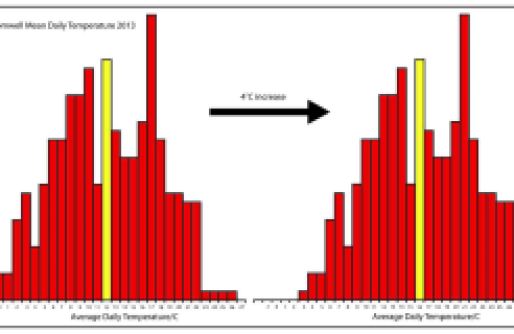New Zealand might be a relatively lucky position as regards global warming. We mostly have a moderate, ‘maritime’ climate. Not too hot, too dry, and except for the dirty dribbles of ice we make so much of, no ice-sheets to melt. We’re not like Australia, where the ‘normal’ run of extreme heat, drought, and fire is likely to become catastrophic in all cases.
If you’ve been paying attention, you’ll know there has been talk around the world of trying to limit global warming to two degrees. Really paying attention means you may know that were dead on track for four degrees if not six…. But tell this to the average person, and they’re likely to wonder what the big deal is. Two, degrees, four degrees, six – not much. Hell, we have much more variation that that most days. So I thought I’d have a crack at trying to show this – and I’ve chosen Cromwell as the example. Cromwell is a town in Central Otago, New Zealand. This is the most ‘continental’ part of our basically maritime country. It’s in a low area surrounded by mountains, so its fairly dry and the winters are frosty. This is good for stone fruit, grapes, and there is a growing trend to grassing areas as grazing for dairy cows.
I checked out the National Climate Database and downloaded the minimum and maximum temperatures for each day in 2013. I averaged each one of these and made a histogram. This shows the number of days experiencing a certain average temperature for the year. You can see the most common temperature was 17C (any temperature from 17 and less than 18C). There was one day with an average of 26C, and one with -1C. The average temperature for the whole year was 12C (marked in yellow). Keep in mind this was for one year only – if I had averaged a whole run of years, the ‘bumps’ would tend to smooth out.
We can then ask ourselves what 4C of warming might mean. Four degrees of global warming may not mean 4C in New Zealand (in polar areas it is likely to be much more), but to keep things simple, let’s assume it will be. Based just on the 2013 histogram we could then expect that we might get one day each year of 27, 28, 29 and 30C – something that didn’t happen in 2013. Days with an average temperature of less than zero may no longer occur. The average will now be about 16C.
Actually this sounds good to me! I could do without the freezing days, and hey, a day at 30C would be perfect for beer, BBQ and swimming. But as for the statistician that drowned in the lake with an average depth of a foot, its the extremes you have to watch out for. I went through the same process for the daily maxima for 2013.
 In 2013 there were 2 days where the temperature hit 34C. But with a 4C increase, there are now two days where the maxima hit 38C. There are now 19 days where the maximum temperature exceeds anything experienced in 2013. The increase in really hot days is the pointy end of climate change. After a 4C rise the wine makers may have given up on pinot noir and switched to shiraz, but spare a thought for the dairy farmers. When the temperature goes above about 27C, dairy cows start to get heat-stressed, and production goes down. After a 4C rise, there might be 3-4 days per year with an average in the heat-stress range. In 2013 there were 42 days where the maxima fell into the cow-stress range. But get this: with a 4C warmer climate, there may be 110 days in the year where the level of 27C is surpassed and dairy cows are put under stress. Significantly more hot days are likely to mean an increase in drought and a heightened risk of fire.
In 2013 there were 2 days where the temperature hit 34C. But with a 4C increase, there are now two days where the maxima hit 38C. There are now 19 days where the maximum temperature exceeds anything experienced in 2013. The increase in really hot days is the pointy end of climate change. After a 4C rise the wine makers may have given up on pinot noir and switched to shiraz, but spare a thought for the dairy farmers. When the temperature goes above about 27C, dairy cows start to get heat-stressed, and production goes down. After a 4C rise, there might be 3-4 days per year with an average in the heat-stress range. In 2013 there were 42 days where the maxima fell into the cow-stress range. But get this: with a 4C warmer climate, there may be 110 days in the year where the level of 27C is surpassed and dairy cows are put under stress. Significantly more hot days are likely to mean an increase in drought and a heightened risk of fire.
Its the extremes that get ya….

